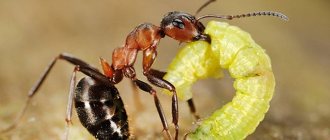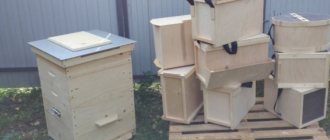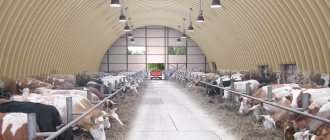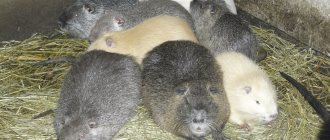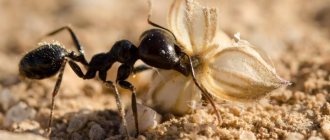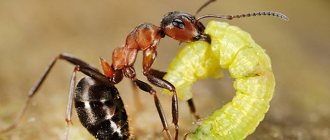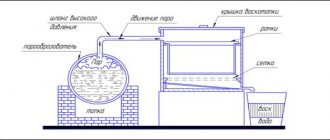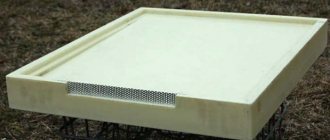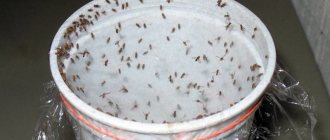What does an ant farm look like and work like?
There are many types of ant farms, everyone can find something to their taste and capabilities
The farm is an artificial anthill. A structure with many passages, tunnels, and paths for movement, which is most often made of plaster, acrylic and special gel. They can be horizontal and vertical, voluminous and flat.
The main thing is that it is suitable for life, so you need to put a small amount of soil inside. Such an environment will allow the ants to feel as if they were in natural conditions; they will create their own passages and holes.
We must not forget that ants need oxygen. They breathe atmospheric air through spiracles - holes in the body through which air enters the insect's body. To make them breathe, you need to make small holes in the structure on the lid, which usually covers the top of the truss.
What types of anthills are there?
So, a home anthill is called a formicarium, it can be compared to an aquarium, only instead of water and fish, we see filler and goosebumps.
There are simple and complex systems in which favorable conditions for the life of insects are automatically created, the correct temperature, humidity, and lighting are maintained. A formicarium can have completely different sizes, from small tabletop ones to huge ones that occupy large areas, it all depends on desire and capabilities. Regarding the filler, it can also be different, for example, gypsum, a mixture of soil and sand, gel.
There are quite popular models “Colosseum” and “Cubus”. The latter are available for sale in the form of a cylinder, cube or display that has double walls. The emptiness of melon products is filled with filler, which can be of different colors. In this filler, goosebumps build their passages and chambers. Regarding the price of such products, it is quite high, about 3 thousand rubles.
There are more affordable models, for example, anthills with helium filler. They are very similar to aquariums, the filling of which is a transparent gel. These formicariums are easy to care for; just open the lid once a week for ventilation. Their approximate cost is 50 rubles.
If we talk about such a filler as gel, it is completely safe for insects, just like for people. In addition to the fact that the gel is a filler, a habitat where goosebumps build their passages and chambers, it also acts as a nutrient medium.
Gypsum trusses can be called the most popular. They come in different shapes, sizes and are painted in all sorts of colors. The cost of such formicaria is on average 700 rubles.
Main types
A horizontal ant farm is inconvenient because it takes up more space than a vertical one.
These designs come in several types:
- Horizontal. These are “lying” farms in which the main slab is located horizontally, as in natural anthills.
- Vertical. The main slab “does not lie”, but is in a standing position, imitating tiered ant dwellings.
- Complex. It combines several types at once: both nests and an arena are located inside, they are larger in size, reminiscent of an ant town.
- Island. The arena is surrounded by a water moat, there is a farm in the middle, no nets or glass are required. The main thing is to monitor the water level and clean the moat.
Ant farms can also be divided according to the material from which they are made. Plaster, acrylic, gel and even wood are used.
The most common designs are made of plaster and acrylic: they are easy to make and do not require frequent repairs. Wooden ones have faded into the background due to the fact that they quickly become unusable: the wood begins to rot, becomes less durable, and falls apart.
Incubator
With the stable development of the ant family, problems may arise with the supply of food inside the incubator, since curious ants will try to run out at any opportunity to explore the surrounding world, and the most daring, courageous and aggressive individuals may attack, since they will regard the intrusion as a threat to the colony.
Of course, such conditions exclude the possibility of quiet feeding, and it is necessary to expand the formicarium area by connecting an arena.
The arena is a structure that plays the role of space outside the nest. In this territory, the ants will collect food, remove garbage, and study various decorative elements previously placed by you. This option greatly simplifies the process of feeding insects - it is enough to simply place a feeder with a treat (syrup, other types of food insects, seeds) in the arena.
How to make a gel farm with your own hands
Gel farm is one of the simplest types
Required tools and materials
A farm with gel filler is very easy to maintain, and the material itself is a source of moisture for ants. This design is similar to an aquarium, but inside there is not water, but a blue or green gel, which is completely safe for insects. This is not only a living environment, but also food.
To create such a design you will need:
- glass aquarium or jar;
- special gel;
- ants.
You can also order a special gel for an ant farm on the Internet, where a wide variety of colors and compositions are available.
Creating such an anthill is extremely simple: just place the gel in a glass container and populate the anthill with inhabitants.
The gel is created on the basis of water and algae, so the ants feed on it without needing feeding. You can buy it ready-made at a pet store, or create it yourself. To do this, water and algae are mixed, which are pre-crushed. The mixture should dry and thicken.
Step-by-step manufacturing instructions
This is one of the easiest ways to create an anthill:
- Prepare a glass container (aquarium, jar), wash it and wipe it dry.
- Then pour the gel into the container. The gel level should be more than half so that the inhabitants of the farm do not feel crowded.
- You can let ants in there - they will dig passages and tunnels themselves.
All that remains is to periodically ventilate the structure and add gel as needed.
Care
Caring for ants does not cause much trouble, because the ant colony is a self-regulating system.
Did you know? These amazing insects are among the oldest species on Earth. The most interesting thing is that ants now look exactly the same as they did a hundred million years ago!
The main thing in this matter is to follow fairly simple rules:
- use sweet compounds or specialized feeds as food (except for keeping in a gel farm);
- do not forget about moistening the soil mixture, for which every week put a wet cotton swab on the lid and change it when it dries completely (for a gel farm this is not necessary);
- the temperature in the room where the formicarium is located should not fall below +15 degrees Celsius;
- do not allow sunlight to enter the ant house, because they love the dark;
- Be sure to remove dead individuals using a cotton pad, this will help avoid disease.
From plaster
To make a gypsum ant farm with your own hands, you will have to spend more time, because... you need to wait for the material to harden
Required tools and materials
To create a gypsum farm, you will need:
- capacity;
- gypsum mortar;
- water;
- cocktail straw;
- pencil;
- drill;
- stationery knife.
Step-by-step manufacturing instructions
- The first step is to prepare a container for diluting gypsum.
- Mix water and plaster until the consistency of thick sour cream.
- Next, you need to leave it to harden for 5-7 days.
- Carefully remove the dried mass from the container.
- Use a pencil to draw future moves and exits.
- You can use a utility knife to drill small paths.
- Place the finished structure in an aquarium or jar of a suitable size.
- Make holes in the lid to allow air to enter.
- In order to moisten the ants' habitat and feed them, insert cocktail straws.
Adviсe
Once you get the ants, distract them with sugar and water to reduce the aggression while you search for the queen. Do not overdo it! Red ants are usually very aggressive, while black ants are generally more passive. For greater effect, you can also plant grass seeds on top. Water the grass carefully to avoid drowning the ants. Don't knock over the jar in the house! A cardboard toilet paper tube makes an excellent pipe. If you are going away for a long time, it would be a good idea if you leave someone to look after the ants so that they do not die from desiccation or starvation. Don't touch the queen, otherwise the rest of the ants will bite you. Ants require the same care as cats or dogs.
Pay attention to them!
Acrylic
For an acrylic farm, the most difficult thing is to form passages and holes for ants
Required tools and materials
- pencil:
- paper;
- acrylic;
- polycarbonate;
- plastic rivets;
- cocktail tubes.
Step-by-step manufacturing instructions
- Develop a project for a future farm. To do this, on a sheet of paper you need to draw with a pencil the future structure, the approximate location of the tunnels, and the dimensions of the structure.
- Take acrylic and follow the example on paper to make small holes, the so-called passages.
- When the structure is ready, fasten it to the walls and polycarbonate lid using plastic rivets.
- Before settling the farm, it is necessary to insert cocktail tubes into the structure so that air, water and food flow through them.
Cleaning the walls of the formicarium
In order to wash the glass of an ant farm, use ordinary ear cotton swabs and cotton pads soaked in water. It should be taken into account that all marks made by ants should not be washed off. Remove only those that interfere with observation and spoil the overall appearance of the ant farm. If you remove all the secretion from the insects, they will apply it again, however, with greater intensity. It is not recommended to clean the acrylic walls of the formicarium using alcohol or chemicals. This causes acrylic glass to become cloudy and may become deformed. When washing glass, do not make fussy movements. Let the ants calm down, carry out the procedure in several stages. After you have cleared the ant marks with a cotton swab, wipe the glass with a cotton pad soaked in plain boiled water. Try not to shake the truss too much while working. If the ants become very agitated, close the lid and give them time to calm down, then continue working later.
Colonization of ants
To find ants, just go outside and find a small anthill
It is very important to remember that you cannot immediately introduce a large number of non-insects into a new home.
Under no circumstances should you put ants from different colonies in one place - there will be a war! In addition, they will gradually begin to multiply and there may not be enough space.
Settlement of residents
After you have purchased and assembled the structure, you need to find residents for the farm.
Where to get ants
There are three options for purchasing insects:
- Catch them in the wild during the season.
- You can buy pets at a pet store throughout the year.
- Buy on specialized web resources.
Important! A fertilized female differs from an unfertilized female by the absence of wings. You can distinguish it from wingless worker ants by its developed chest (due to the remaining flight muscles) and massive abdomen. After mating, the females land, break their wings and look for a place to build a nest
At such a moment you need to catch them, one or several at once.
After mating, the females land, break their wings and look for a place to build a nest. At such a moment, you need to catch them, one or several at once.
Move-in process
A captured queen should not be placed immediately in the nest as she will be difficult to care for. To begin with, it is placed in a regular medical test tube with moist soil, or in a special core filled with soil or plaster. Egg laying begins a few days after summer. The first babies appear after 60-90 days, and the new family can already be fed with carbohydrate and protein food. When the colony has more than 20 individuals, it can be moved to a prepared artificial anthill.
If you still decide to just watch the ants in order to later breed a full-fledged colony, then collect the workers from the anthill and place them in your farm.
There is an easy way to catch ants - lure them into a jar with sweet bait.
Once you bring the insects home, place them in the refrigerator until they become sleepy, about 15 minutes.
After this, carefully move them to the farm, to the arena. Do the same with an ant family bought in a store.
Important! Do not shake ants into the arena, especially pupae, larvae and eggs. This way they can be injured, and the brood will stop developing or be born with defects.. Having placed the incubator in the arena, humidify the farm, darken it and wait until the scouts examine the new housing and report to the queen
After this, she will move from the incubator to the formicarium, and the workers will transfer the brood there. When there is no brood left in the incubator, you can drive out the last adults with light taps.
After placing the incubator in the arena, humidify the farm, darken it and wait until the scouts examine the new housing and report to the queen. After this, she will move from the incubator to the formicarium, and the workers will transfer the brood there. When there is no brood left in the incubator, you can use light tapping to drive out the last adults.
How to care for an ant farm
It should be remembered that the farm is periodically filled with soil and sand so that the insects feel as if they were in natural conditions. It is important to add some water and food.
The glass is wiped, and the farm itself is ventilated. Ants need shade, so it is better to keep their home away from light and avoid direct sunlight.
Creating an ant farm is not as difficult as it might seem at first glance. It is enough to read the instructions and the list of necessary tools and materials, which are easily accessible and inexpensive.
Preparatory stage
When you have decided where to get the ant family, start preparing their home. This is a very important stage, because, in addition to providing the insects with everything necessary for their life, it is necessary to ensure the complete tightness of the formicarium. Otherwise, the pets will crawl throughout the house.
The first step is to prepare a container into which the filler will later be placed to ensure vital functions. According to experienced specialists, the best option is two glasses, which are fastened together by a frame, and the filler is poured between them. Making such a container will require a little time and some skills.
Facilities
Gazebo, pergola, sandbox, veranda, well - these and other structures made of wood look very impressive. To make them, you can use timber, slats, logs.
But these are all fairly traditional materials. Or you can look in the forest for tree trunks blown down by the wind, cut the logs to the same length, remove the bark (or not) and dig them into the ground, having previously treated the underground part with a special compound that will protect the tree from rotting.
The roof of the gazebo can be made of straw or willow. The result will be something like a bungalow. Very creative.
Warnings
You should also know what not to do when using formicarium:
- close the lid tightly, insects need air to breathe;
- the holes in the lid for ventilation should be of such a size that pets cannot escape from you;
- do not allow strong cooling, otherwise you will be in sleep mode;
- ants are contraindicated in extreme heat, which will lead to the death of insects;
- do not shake or drop the formicaria;
- do not pour water, the ants cannot swim and will simply die.
In conclusion, let’s say that by creating a formicarium with your own hands, you will make a unique specimen, thanks to which you will be able to observe the life of your unusual pets.
Garden furniture
Wooden garden crafts can become quite functional if they serve as garden furniture. Of course, to make furniture you need to have certain skills in working with wood and professional tools.
The same logs and logs are suitable as starting materials; a stump can make an excellent bench. For the top of a garden table, you can use thick plywood.
Since all these items will be in the open air around the clock, it is necessary to take care of moisture protection, protection from mold and drying out. And all surfaces must be carefully polished and sanded so that splinters do not spoil your vacation outside the city.
